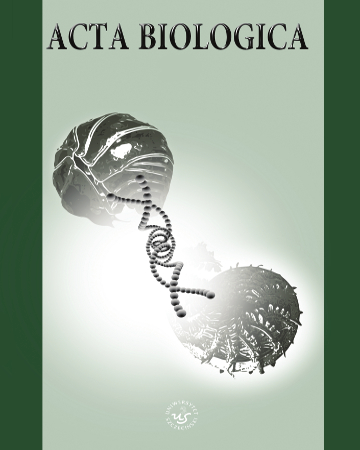
ISSN: 2450-8330
eISSN: 2353-3013
OAI
DOI: 10.18276/ab.2020.27-03



Issue archive /
No. 27
A note on centrifugation for improving freshwater invertebrate sample conservation
| Authors: |
Antonio G.
Valdecasas

Museo Nacional de Ciencias Naturales, CSIC, José Gutiérrez Abascal, 2, 28006-Madrid, Spain Ricardo García-Jiménez 
Museo Nacional de Ciencias Naturales, CSIC, José Gutiérrez Abascal, 2, 28006-Madrid, Spain Mercedes Marín F.-Campoamor 
Paseo de la Chopera, 11. 28045 – Madrid. Spain |
| Keywords: | live sorting sampling trips optimal sample conservation benthos streams |
| Data publikacji całości: | 2020 |
| Page range: | 9 (21-29) |
Abstract
Sorting of freshwater invertebrate samples is best done while the animals are still alive.
However, sorting in the field generally means less overall sampling can be done in the allotted time. Placing samples under cold conditions has been the traditional way to extend the life of the organisms contained within them. In this work, we evaluated whether the addition of a centrifugation step extends the survival time of organisms post-sampling, thus providing more time for sorting. Three salad spinners were tested for their capacity to extract water from samples. Additional observations were made on the compaction of samples due to excessive centrifugation. We conclude that adding a short centrifugation step of 30 seconds prolongs the life of several freshwater invertebrate taxa, including Hydrachnidia, Nematoda and Ostracoda. Furthermore, when fixation of samples in the field is necessary, centrifugation reduces the amount of fixative to be added to the samples to reach a certain concentration. Fixed samples can also be centrifuged, which may be particularly relevant when sampling abroad as inflam-mable liquids are often prohibited on planes. In our experience, centrifuging fixed samples does not compromise the fixed organisms, or their genetic material.
Download file
Article file
Bibliography
| 1. | Anderson, J.T., Zilli, F.L., Montalto, L., Marchese, M.R., McKinney, M., Park, Y.L. (2013). Sampling and |
| 2. | Processing Aquatic and Terrestrial Invertebrates in Wetlands. In: J. Anderson, C. Davis (eds.), Wetland |
| 3. | Techniques. Dordrecht, The Netherlands: Springer. |
| 4. | Andreu, E., Camacho, A. (2002). Recommendations for sampling water, biota and bottom sediments in Ramsar |
| 5. | wetlands (bilingual Spanish-English). Madrid: Ministerio de Medio Ambiente. |
| 6. | García-Jiménez, R., Horreo, J.L., Valdecasas, A.G. (2017). Minimal barcode distance between two water mite |
| 7. | species from Madeira Island: a cautionary tale. Experimental and Applied Acarology, 72, 133–143. DOI: |
| 8. | 10.1007/s10493-017-0147-5. |
| 9. | Hauer, F.R., Resh, V.H. (2006). Macroinvertebrates. In: F.R. Hauer, G. Lamberti (eds.), Methods in Stream |
| 10. | Ecology (chapter 20). Academic Press. |
| 11. | Kalloniatis, M., Luu, C. (2007). Visual Acuity by Michael Kalloniatis and Charles Luu. Webvision. The |
| 12. | Organization of the Retina and Visual System, 5. Retrieved from: https://webvision.med.utah.edu/ book/part-viii- |
| 13. | psychophysics-of-vision/visual-acuity. |
| 14. | Schwoerbel, J. (1970). Methods in Hydrobiology. Pergamon Press. |
| 15. | Stryjecki, R., Bankowska, A., Szenejko, M. (2018). A faunistic and ecological characterization of the water |
| 16. | mites (Acari: Hydrachnidia) of the Bukowa River (central-eastern Poland). Acta Biologica, 25,77–94. |
| 17. | Tachet, H. (2000). Invertébrés d’eau douce. Sytematique, biologie, ecologie. Paris: CNRS editions. |
| 18. | Valdecasas, A.G., Aboal, M., Cirujano, S., Iepure, S., Jaume, D., Proctor, H., Velasco, J. L. (2010). Sampling |
| 19. | continental freshwater. In: J. Eymann, J. Degreef, C. Häuser, J.C. Monje, Y. Samyn, D. Vandenspiegel (eds.), |
| 20. | Manual on Field Recording Techniques and Protocols for All Taxa Biodiversity Inventories (pp. 213–272). Abc |
| 21. | Taxa cap. 10. |